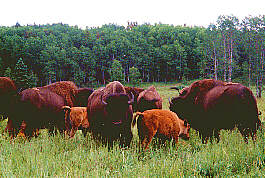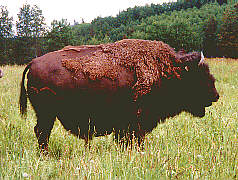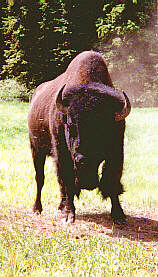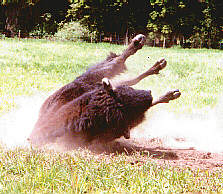 Bison
Ranching
Bison
Ranching
Bison once inhabited the plains of North America in vast numbers, providing the Plains Indians with food, clothing, shelter and a large part of their culture.
They also played a great part in sustaining the lives of explorers and settlers heading west. But by the late 1800's these majestic beasts were on the brink of extinction. Through the insightful efforts of conservationists and farmers the bison is no longer an endangered species.
The bison farming industry in British Columbia has been growing slowly since the early 1980's and at present there have been 63 permits issued to farmers. At this time a total of 5179 bison, excluding their calves (of which approximately 2000 are born per year), are located throughout the province. Sale prices for this animal are not cheap. At recent auctions, prices for cow/calf pairs were an average of $3900 and two year old bulls obtained prices nearing $63,000 US.

As today's world becomes more health conscious, people are drawn towards the healthy alternative that is bison meat. Once served as a novelty item in restaurants, it has in the last five years become a gourmet food of sorts. With more protein per ounce because of a lower marbling and fat content, a lower cholestrol level than beef, chicken and turkey is achieved. The meat is similar to that of beef but may be richer, leaner and have shorter fibres. A good distribution of amino acids gives the meat a more complete protein content and the fatty amino acid distribution is in smaller amounts, which is a positive aspect for many heart patients. The meat also has a higher iron content, giving it a darker red colour than that of beef. The bison farming community is said to oppose the use of hormones, artificial growth stimulants and sub-therapeautic drugs. Prices for bison meat may average $28.00/lb for individual cuts and $3.50/lb for a side of bison.
The demand for bison and bison meat has grown rapidly in recent years. Factors such as the unpredictability of other red meat industries and the knowledge that bison are 10 to 15% more efficient to graze than cattle are catching the interest of once cynical prospective ranchers.
Although they often appear awkward and lethargic, these great beasts are agile and quick and can easily out-run and out-manuever a horse or jump any fence a deer can. They are generally a docile creature and will allow their keeper to approach them but, being wild animals, they are often unpredictable and may charge either man or machine if they feel threatened.
 Bison
farmers report that they can be penned with cattle with no ill effects but
horses are not recommended as the bison will often hook the horse with its
horns. Sheep should not be kept nearby as they carry diseases that bison are
particularily suscebtible to. At present there is no tuberculosis test available
for llamas so it is advised that they not be kept nearby.
Bison
farmers report that they can be penned with cattle with no ill effects but
horses are not recommended as the bison will often hook the horse with its
horns. Sheep should not be kept nearby as they carry diseases that bison are
particularily suscebtible to. At present there is no tuberculosis test available
for llamas so it is advised that they not be kept nearby.
Bison still have their natural instincts for survival and can endure blizzards that would easily kill a herd of domestic cattle. During the winter months their dark brown coats are thick and wooly, providing ample protection from the elements. It is not uncommon for a bison to root through a deep snow cover to the grass below or even eat snow to survive a particularily harsh storm. Because these animals are not domesticated, cows do not allow or need any assistance during calving. The self-sufficient characteristic typical of bison is one that owners admire.
A cow will breed at the age of two and after a 275 day (over 9 months) gestation period, a calf is born. These calves are born a reddish-brown which will turn a darker brown after 3-4 months. Standing immediately, they soon have no problem keeping up to their mother at a steady run. These vigorous newborns nurse much more frequently than beef calves and begin eating forage from day one. Growing rapidly and easily they will weigh 300-400 pounds (136-182 kg) after the first year. After the age of three they will produce a calf each year until they are 30 or 40 years old. It is not uncommon for a cow to reach 1000 lbs (455 kg) when she reaches maximum growth after her fifth or sixth year and a bull will weigh from 1500-2000 lbs (682-910 kg) by the time he is eight or nine years old.
The bison is a curious animal that responds well to being penned and will come to a bucket of grain or their keeper's voice. They adapt to any type of climate from Kodiak Island and the Dakotas of the USA to the lush Hawaiian Islands. With proper disease and parasite management, they thrive in hot climates. If, however, the quality and quantity of the feed available is poor, they are less likely to reproduce well. They can survive for two or three days without water when roaming for suitable rangeland.
 For
those interested in bison ranching there are a few things to consider. Handling
facilities are similar to that of cattle but fences must be a minimum of six
feet and chutes and squeeze chutes must be hardier than those used for cattle.
Bison do not respond well to the herding technique used with beef cattle so
this must be taken into account when facilities are being constructed. Bison
generally respect fences but if their needs are not met the wild instinct
to roam will surface and fences become a minor deterrant to this powerful
animal. Ample feed and water and a constant supply of salts and minerals are
necessary to prevent them from looking elsewhere. A game farm license is required
for a bison farming operation as well as permits to transport the animal.
Annual tuberculosis tests are mandatory. Good breeding programs are important
but not always practiced and inbreeding does occur. One should watch for signs
such as small animals, sickle hocks and concave faces when purchasing stock.
For
those interested in bison ranching there are a few things to consider. Handling
facilities are similar to that of cattle but fences must be a minimum of six
feet and chutes and squeeze chutes must be hardier than those used for cattle.
Bison do not respond well to the herding technique used with beef cattle so
this must be taken into account when facilities are being constructed. Bison
generally respect fences but if their needs are not met the wild instinct
to roam will surface and fences become a minor deterrant to this powerful
animal. Ample feed and water and a constant supply of salts and minerals are
necessary to prevent them from looking elsewhere. A game farm license is required
for a bison farming operation as well as permits to transport the animal.
Annual tuberculosis tests are mandatory. Good breeding programs are important
but not always practiced and inbreeding does occur. One should watch for signs
such as small animals, sickle hocks and concave faces when purchasing stock.
It is encouraging to see the steady growth of the Bison industry in British Columbia. Rescued from the brink of extinction, with careful management these powerful and majestic animals should graze the fields for generations to come.

